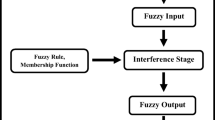Abstract
Machine vision, hearing are greatly developed in the domain of robotics and some of them have been used for practical purposes. However, the progress made in machine taste and smell sensation is far from satisfaction. A Takagi-Sugeno (T-S) model for recognizing the taste signals of tea is proposed. In the model, a hierarchical genetic algorithm is used to extract fuzzy if-then rules, and it can obtain the near-optimal structure of T-S model for taste identification of tea. Numerical simulations show the effectiveness of the proposed algorithm.
Access this chapter
Tax calculation will be finalised at checkout
Purchases are for personal use only
Preview
Unable to display preview. Download preview PDF.
Similar content being viewed by others
References
Yokoyama, A., Uchida, H., Katsude, T.: Quantitive sampling analysis for a taste sensor. In: The 3rd International Conference Engineering Design and Automation, pp. 7–10. The Institute of Electrical Engineers of Japan, Tokyo (1999)
Huang, Y.-X., Zhou, C.-G., Zou, S.-x.: A fuzzy neural network system based on the class cover and particle swarm optimization. Journal of Computer Research and Development 41(7), 1053–1061 (2004) (in Chinese)
Katsube, T., Umetani, S., Shi, L., Hasegawa, Y.: Sensor Fusion for Taste Sensor and Odor Sensor. Chemical Senses 30(1), 260–261 (2005); Saeko Ishihara, Atsushi Ikeda, Daniel
Citterio, Maruyama, K., Hagiwara, M., KojiSuzuki: Smart Chemical Taste Sensor for Determination and Prediction of Taste Qualities Based on a Two-Phase Optimized Radial Basis Function Network. Anal. Chem. 77(24), 7908–7915 (2005)
Takagi, T., Sugeno, M.: Fuzzy identification of systems and its application to modeling and control. IEEE Trans. on Systems, Man and Cybernetics 15(1), 116–132 (1985)
Ke, J.Y., Tang, K.S., Man, K.F., Luk, P.C.: Hierarchical genetic fuzzy controller for a solar power plant. In: Proc. of the IEEE International Symposium on Industrial Electronics, pp. 584–588 (1998)
Osamu, T., Hajime, K., Shigenobu, K.: Protein folding by a hierarchical genetic algorithm. In: The 4th International Symposium on Artificial Life and Robotics, pp. 334–339 (1999)
Yen, G., Lu, H.: Hierarchical Genetic Algorithm for Near-Optimal Feedforward Neural Network Design. International Journal of Neural Systems 12(1), 31–43 (2002)
Zheng, Y., Zhou, C.-G., Huang, Y.-X.: Taste Identification of Tea Through a Fuzzy Neural Network Based on Fuzzy C-means Clustering. Mini-Micro Systems 25(7), 1290–1294 (2004) (in Chinese)
Author information
Authors and Affiliations
Editor information
Editors and Affiliations
Rights and permissions
Copyright information
© 2009 Springer-Verlag Berlin Heidelberg
About this paper
Cite this paper
Ma, M., Zhang, LB., Sun, Y. (2009). Recognizing the Taste Signals of Tea Using T-S Fuzzy Model. In: Cao, B., Li, TF., Zhang, CY. (eds) Fuzzy Information and Engineering Volume 2. Advances in Intelligent and Soft Computing, vol 62. Springer, Berlin, Heidelberg. https://doi.org/10.1007/978-3-642-03664-4_80
Download citation
DOI: https://doi.org/10.1007/978-3-642-03664-4_80
Publisher Name: Springer, Berlin, Heidelberg
Print ISBN: 978-3-642-03663-7
Online ISBN: 978-3-642-03664-4
eBook Packages: EngineeringEngineering (R0)




